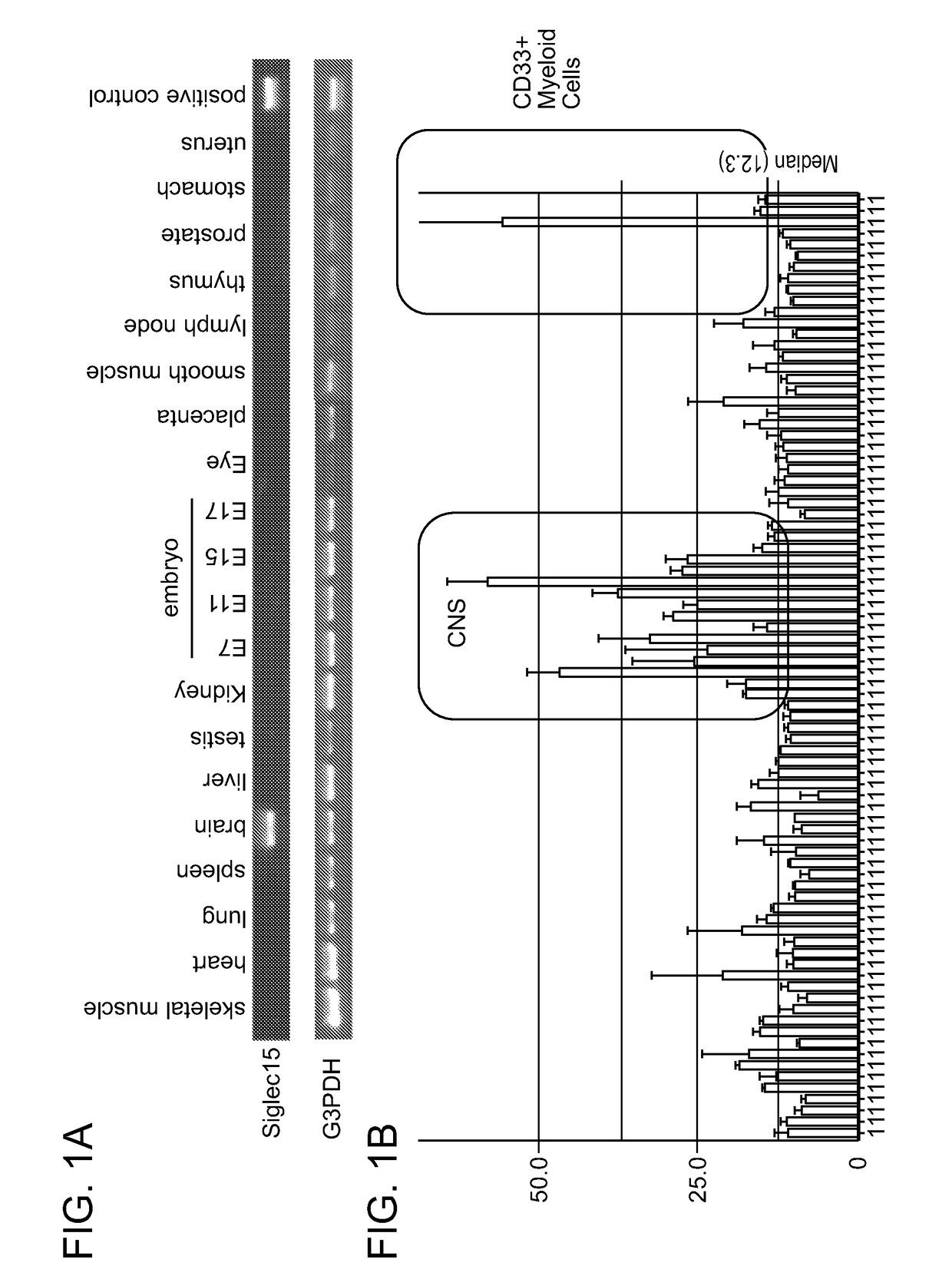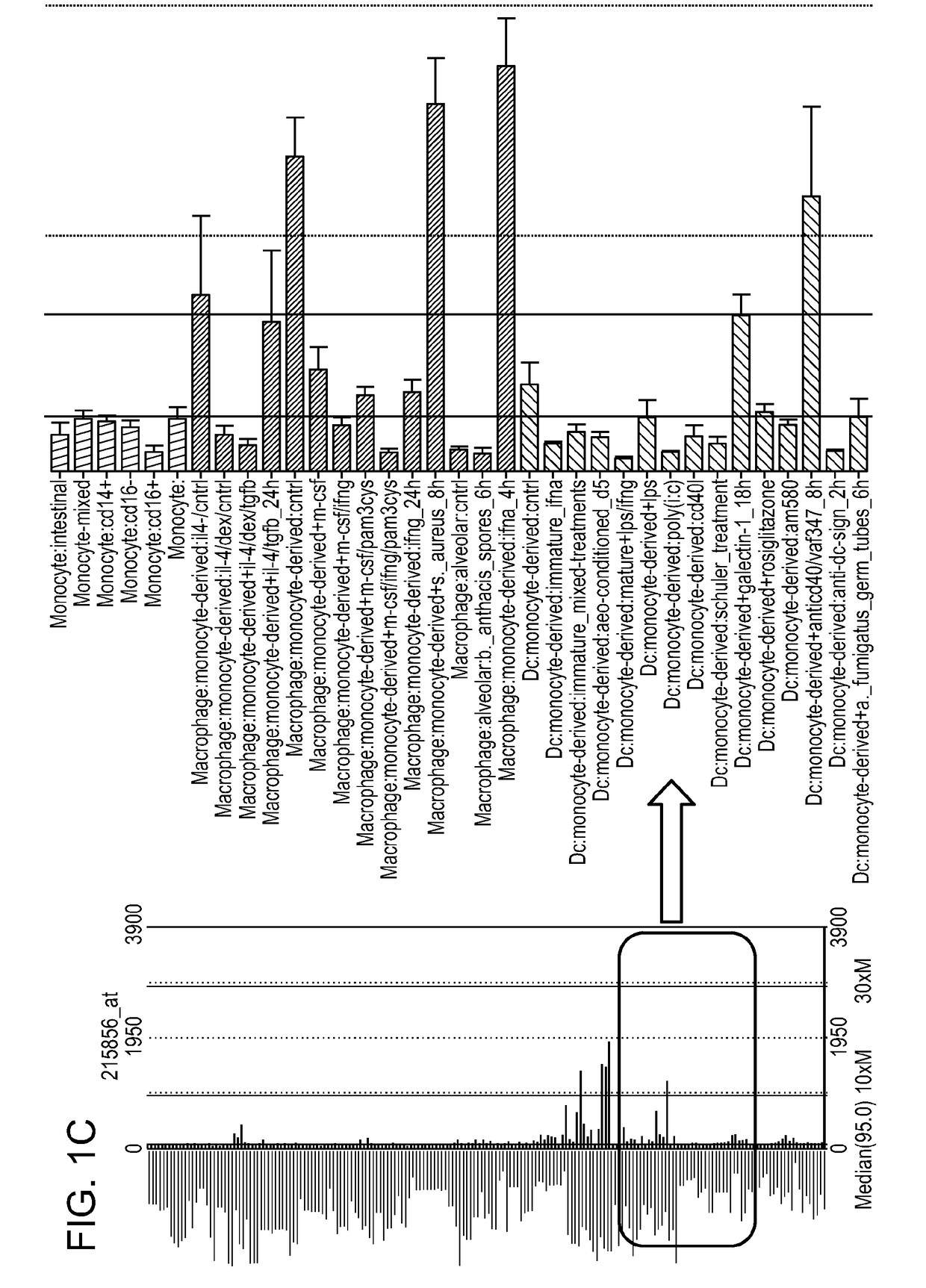Compositions and methods for treating autoimmune diseases and cancers
a technology for cancer and autoimmune diseases, applied in the field of compositions and methods for treating autoimmune diseases and cancers, can solve the problems of reducing tumor size, prolonging reducing tumor size, so as to prolong the survival of mice with brain tumors, reduce tumor size, and reduce expression
- Summary
- Abstract
- Description
- Claims
- Application Information
AI Technical Summary
Benefits of technology
Problems solved by technology
Method used
Image
Examples
example 1
ation of Siglec 15 by Genome-Scale T-Cell Activity Array Technology
[0256]In order to conduct human genome-wide searches of targets for immunotherapy, a genome-scale T cell activity array (GS-TCAA) was developed. 6402 human membrane cDNAs, covering 90% of the human membrane genome, were prepared using Qiagen miniprep kits, quantified and diluted for GS-TCAA construction.
[0257]A set of human receptor arrays containing four 1536-well plates was spun down (600 g, 2 min), followed by reverse transfection. Briefly, 1536-well array plates were dispensed with 2 μl optiMEM containing lipofectamine 3000 (7 μl lipo / ml) per well using a robotic dispenser (Multidrop Combi, Thermo Scientific), and quickly shook for 1 min by an ultra-speed orbital shaker. All plates were stored in room temperature for 20 min, followed by the addition of 293T.2A.m.anti-CD3 cells for T cell stimulation (2000 cells in 4 μl per well) by Multidrop. After that, the plates were further spin down (1000 g, 4 min) to get ri...
example 2
Myeloid-Related Expression of Siglec 15
[0258]Siglec 15 expression was evaluated in different mouse tissues using RT-PCR with a mouse cDNA library (Clontech Laboratories). A Siglec 15 plasmid (Origene) was used as a positive control. Results are shown in FIG. 1A. Microarray analysis of Siglec 15 RNA expression in human tissues (BioGPS.org) is shown in FIG. 1B. This data indicates that Siglec 15 is expressed in brain and myeloid-related cells in both human and mouse, under normal conditions. Microarray data from BioGPS is presented in FIG. 1C, demonstrating that Siglec 15 is expressed on monocytes, macrophages, dendritic cells, B cells, and osteoclasts. Accordingly, Siglec 15 may have a physiological function in brain-related diseases, and / or regulation of immune response.
example 3
n of Siglec 15 in Cancer
[0259]A meta-analysis of Siglec 15 expression in human cancer was performed using the TCGA cancer microarray database. Siglec 15 mRNA expression in many human cancers was compared to counterpart normal tissue (FIG. 2). Original datasets were normalized using the UCSC Cancer Genomics Browser software (https: / / genome-cancer.ucsc.edu), and were analyzed using the R program. This data indicates that Siglec 15 is over-expressed in many human cancers, and may play a role in cancer development and progression.
[0260]Siglec 15 expression was also evaluated in several human cancer cell lines. Expression of Siglec 15 in human cancer cell lines was determined by NCI60 microarray (BioGPS) (FIG. 3A, expression values are shown in arbitrary units). Several human cancer cell lines were stained with anti-Siglec 15 antibody m03. Antibody m03 was generated by immunization of NZB / W Fl mice with a mouse Siglec15 ectodomain fusion protein, and cross-reacts with human Siglec 15. St...
PUM
| Property | Measurement | Unit |
|---|---|---|
| size | aaaaa | aaaaa |
| sialic acid | aaaaa | aaaaa |
| cell-adhesion | aaaaa | aaaaa |
Abstract
Description
Claims
Application Information
 Login to View More
Login to View More - R&D
- Intellectual Property
- Life Sciences
- Materials
- Tech Scout
- Unparalleled Data Quality
- Higher Quality Content
- 60% Fewer Hallucinations
Browse by: Latest US Patents, China's latest patents, Technical Efficacy Thesaurus, Application Domain, Technology Topic, Popular Technical Reports.
© 2025 PatSnap. All rights reserved.Legal|Privacy policy|Modern Slavery Act Transparency Statement|Sitemap|About US| Contact US: help@patsnap.com



